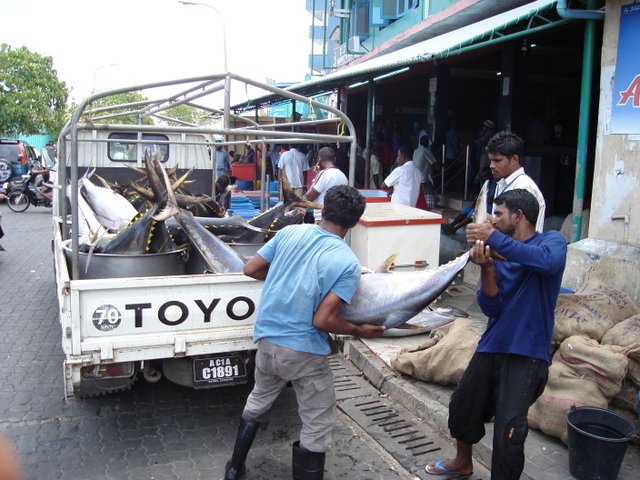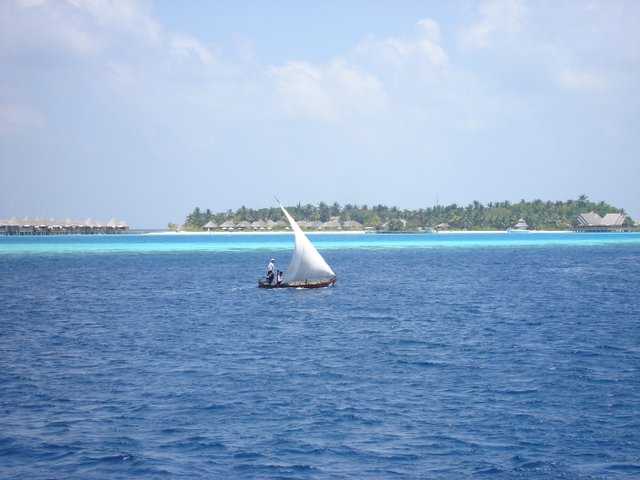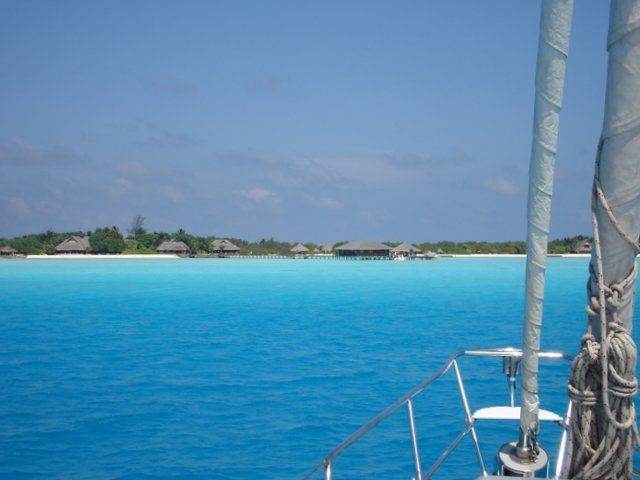The Maldives is a country made up of 26 coral atolls strung across the Indian Ocean to the southwest of India in a row extending north and south for about 450 nautical miles. Most of the reefs in the atolls do not reach the surface, but there are still nearly 1200 islands, of which about 200 are inhabited. In fact the English word atoll takes its origin from the Maldivian language, Dhivehi. While the population of the Maldives is about 300,000 (supposedly 100% Sunni Muslim), it receives about 600,000 tourists annually. Most of them never see the capital city of Male because they are whisked directly from the airport on an adjacent island by speedboat or sea plane to one of the 80-odd posh island resorts where they spend gobs of money to chill out on their vacation or honeymoon. For us, the Maldives offered a nice halfway stopover point where we could change crew, fuel, provision and rest a bit while were making the 3500 mile trip across the Indian Ocean from Southeast Asia to the Red Sea.
From a few miles out to sea, we assumed that making landfall at the island of Male was much like approaching any other tropical island. Before the land itself appears over the horizon, one can see the tops of palm trees and perhaps towers or taller buildings. As we made landfall and the features came into view, we could see that the spikes on the horizon were not palm trees at all, that in fact Male was completely covered with mid-rise buildings. We weren’t exactly expecting to see a miniature Singapore situated in the middle of the Indian Ocean, but weren’t overly surprised considering the two square kilometer coral island is home to about 100,000 Maldivians.
Approaching Male from seaward.
Arriving in the late afternoon from our 1200-mile, 7-1/2-day passage from the Andaman Islands, we were happy to have a few sundowners and a quiet evening at anchor before grinding through the check-in formalities. Anchoring itself was a challenge, as most of the area specifically designated for arriving vessels was between 25 and 40 meters deep. Male seems rather lacking in facilities to handle the constant flow of heavy shipping traffic, let alone a few dozen pleasure yachts that come passing through each season Local boats had hooked on the few shallow bits in the protection of the island of Male. We finally got settled in a 25 meter patch, but spent the evening rocking and rolling in the refracted trade-wind swell exacerbated by the swift currents running through the narrow channels between the islands and reefs. We contacted our agent Abdullah, who indicated he would tee up all the appropriate officials so that we could check in the next morning at 0930.
0930 came and went without word from Abdullah and we were unable to reach him by cell phone or VHF. When we finally made contact late in the morning, he informed us that the time had been pushed back to 1230 hours. At least we had the morning to tidy up “Moonshadow” from the passage. 1230 came and went with no activity. Finally at about 1530, we were instructed to come into the small commercial harbor and med-moor to the bulkhead. Abdullah, along with all the officials, were there to catch our stern lines. Customs, Immigration and the Coast Guard all came on board. They were all professional, efficient and polite young men who spoke English reasonably well. Within a half an hour all the paperwork was filled out, chopped and the formalities were completed. We were granted one month visas and received a permit to cruise within the North and South Male Atolls. If we had wanted to visit any of the other atolls, we would have to apply for a special permit and cough up another US $400. There seemed to be enough to keep us busy in these two atolls that we didn’t opt to go afar.
We were all keen to get off the boat and have a meal on shore, so on recommendation of Abdullah, we headed down the waterfront a ways to the Nasandhura Palace Hotel for dinner at their outdoor courtyard restaurant. The food was good, but since the Maldives is a strict Sunni Muslim society, the strongest thing we could get to drink was non-alcoholic beer. Served icy cold, it was tasty and refreshing, and put out the fires of the spicy curry dishes we’d ordered.
After dinner we took a stroll home along the lively waterfront of Male, passing the local fish and fresh produce markets. There was quite an assortment of fish on offer, but tuna seemed to be the main course. It is apparently the staple protein in the Maldivian diet, which comes as no surprise considering the seas surrounding the Maldives produce some HUGE specimens. We saw a few nice fish laid out that were more than a meter long and must have weighed well over a hundred pounds each. Moving one around was a two-man job.
A delivery of tuna to the local fish market.
The following day we took a stroll around the narrow and winding streets of town to stretch our legs a bit and check things out. Friday is the Muslim “weekend” holiday so most businesses, banks and government offices were closed. Quite foreign to us westerners, everything is open for business from Saturday through Thursday. Imagine popping into your bank to do business on a Sunday morning. Late in the afternoon, some of the smaller family owned businesses opened for a few hours. Five times a day, starting from very early in the morning, the city echoes the call to prayer through amplified speakers in the minarets. Almost everyone would dash off to their mosque, wash themselves in the long sinks attached to an outside wall, and commence prayer. Shops close, the city becomes almost quiet, and if there isn’t enough room in one’s mosque of choice, people lay down their prayer rug right on the street or sidewalk, and pray facing Mecca, even if they are facing straight into a wall.
Most of the men we saw wore casual western style dress, but the women generally were fully covered from the neck down and wearing head scarves. We were told that the dress code used to be more relaxed and this practice only started after 9-11, perhaps as a show of Muslim solidarity.
The style of architecture in Male is a blend of east and west. The basic simplicity of the Middle East is ever present, but there is the occasional western flair. The city is reasonably tidy, but since nearly every square foot is built up, it is lacking much greenery or open space. The roads are so narrow in places that one has to scrunch up against the wall to let cars pass without getting clipped by a rear view mirror. Many home fronts are not much more than a door through an outside wall or a gate leading to a small private courtyard. Homes appeared to be small and crowded, and many doorways opened straight into the living room. We heard that in many cases, people sleep in shifts as there are not enough beds for everyone. Overall, the standard of living in Male appeared to be relatively high compared to its neighboring countries, due mostly to the Maldives’ thriving tourism industry.
We were quite pleasantly surprised by the variety of goods on offer in town. A couple of grocery stores had many “ex-pat” items available. Prices for most fresh items were quite high as most everything had to be flown in from Australia or Asia. A cantaloupe cost US $10, a head of lettuce was priced at $8 and an avocado was $5. There were a couple of reasonably well stocked chandleries, some decent hardware stores and a couple of fishing gear shops where we were able to get a few necessary supplies. We even found a store specializing in reverse osmosis water makers and were able to purchase some second-hand spare parts for our 20 year old Sea Recovery unit. The only thing seemingly not available in Male was adult beverages. There were many non-alcoholic beers and sparkling wines on offer, and tonic water but no gin. How does one drink tonic water without gin?? If you wanted a drink, you had to take a ferry to the airport hotel, on another island, where there was a western style restaurant and bar.
Male has plenty of restaurants and cafes, offering all sorts of food such as Chinese, Italian, Indian and Thai. We enjoyed some excellent meals out and the prices were very reasonable. If the Maldivians don’t partake in drinks, they make up for it with ice cream. Cafes specializing in all sorts of delectable desserts were popular, and it wasn’t uncommon to see the locals devouring more than one fancy ice cream creation after a meal.
Most everyone we came in contact was friendly, extremely helpful and spoke English well. If we inquired about something, we were often personally led to the shop where it could be found, or even driven if it was further away. If someone wasn’t able to answer our question, they would usually pull out their cell phone and make a call to get the information for us.
Being tied up in Male’s commercial harbor was interesting. Outside the harbor there was a constant parade of ships, ferries, yachts, fishing boats, small local boats called dhoanis, and live aboard tourist charter boats called “safari boats.” Inside the harbor, very primitive wooden cargo boats, looking to be vintage late 19th or early 20th century, laden with bananas, limes, cabbage and other produce from India and Sri Lanka, came along side and were offloaded with cranes, nets and lots and lots of strong hands and backs. A couple of days in the noisy and dirty port were enough so we headed out to the popular visiting boat anchorage of Hulhumale.
Hulhumale is a lagoon that is alongside what was once a large coral patch that has been reclaimed for the expansion of the city of Male. While very little has been built on the new island, there is regular ferry service to Male, about 20 minutes away, for 5 Rufia or about US 40 cents each way. In addition to a few apartment blocks and a very large and ornate mosque, Hulhumale Island has a few small grocery stores, cafes and an Internet café. We also were able to get petrol for the dinghy at a “service station” which was a couple of tanker trucks fitted with metered pumps parked under an awning.
From there we headed northwards on the east side North Male Atoll to check out a couple of dive sites. After a couple of attempts to anchor on or near some recommended dive sites, we gave up. Lacking local knowledge, we had difficulty anchoring in the deep passes awash in wicked currents, in some cases more than 4 knots. Diving was akin to swimming inside a huge washing machine. Graham and Thane were quite keen so they contacted a local dive boat and organized a trip to some good sites. This worked out much better and they got in a couple of excellent dives. Merima I planned to hang out for awhile so we thought we’d get it sussed so we could dive on our own.
We enjoyed a week or so of island hopping through the atoll, anchoring off of gorgeous US $1,000 a night resorts, snorkeling in the clear blue waters, and then returned to Hulhumale to drop Thane at the airport. We then headed out for a few more days of island hopping and did manage to find one very nice dive site at a place called Baros Thila where we could hop over to the drop point by dinghy and dive on a very nice wall.
A local sailboat off one of the many Maldivian luxury resorts.
A thila is a patch of coral reef inside the atoll a couple of meters below the surface. In the case of Baros Thila, there was a long stretch where the reef made a near vertical drop from a few meters below the surface to more than 20 meters to a sand bottom. There were some interesting caves and overhangs, nice soft corals and plenty of large fish lurking on the eastern most point of the thila waiting for their daily meal to arrive in the current. I’m not sure if it was the time of day, or the moon’s cycle, but the current there was negligible on three different dives. We seemed to have cracked the code, at least at this spot.
We hopped across North Male Atoll back to Hulhumale and dropped Graham at the airport. It’s always great to have our friends with us, particularly on long passages, but after six weeks with guests on board, Merima and I were ready to shift gears and enjoy some quiet island time out on our own. We hopped the ferry into Male to pick up a few fresh provisions, enjoy a meal out and a stroll on dry land, and then headed off to see a bit of South Male Atoll.
Our first stop was a well protected anchorage off of Velassaru Island where we chilled out for a few days. We had heard that many of the resorts weren’t too friendly to yachties, but when we went ashore there at the Laguna Maldives Resort, they welcomed us in for dinner. We chose to dine at “The Grill” out on the beach and enjoyed a candle lit dinner of local fish right on a sugar sand beach with the stars reflecting off the calm lagoon. Merima enjoyed a night off from galley duty and I didn’t miss doing dishes!
We had heard from some cruising friends that there was some good and easy diving on the other side of the atoll, so we headed east to a large and shallow anchorage off of Eboodhoofinolhu Island. The shallow depth and white sand bottom gave the massive lagoon the color of a swimming pool.
Anchored in a calm lagoon.
The current was strong in Embudhoo Kandu, the channel to the south of our anchorage, so we decided to dive it with mask and snorkel, and drift along with the current, dinghy painter in hand. This worked out pretty well and we saw some very large fish and manta rays as the sea bottom went by at 2-3 knots.
We enjoyed a couple of days in this anchorage off of Eboodhoofinolhu Island, and went in for a nice dinner at the Taj Exotica resort there. This resort was rated as one of the top five in the Maldives. While the food was nicely prepared and the staff very friendly, the timing was all off so we didn’t feel the service deserved this rating. After dinner we shifted to the bar for a nightcap, where we were greeted, seated and then ignored, so we had the nightcap on board “Moonshadow.”
With just a week left before we planned to sail for the Middle East, we headed back to Hulhumale to get fuel and provision for the trip the rest of the way across the Indian Ocean to Salalah in Oman.
Fuel was brought to us by a small barge that came along side us in Hulhumale. It was clean and very easy. We provisioned up in Male, finding almost everything we needed, and even managed to organize a bootleg shipment of beer/wine and spirits from one of the wholesalers who sell to the resorts, so we were able to top up the fun locker.
We spent just over a month in the Maldives due to crew/guest schedules. It was probably a week or so more than we would have liked as there is not much for the cruiser to see or do from a leisure standpoint, other than anchor off of resorts and dive. As we mentioned, the diving is reasonably good but can be a challenge on your own due to the depths and currents so if you wish to dive on the best sites it is better accomplished by hiring a local dive boat. Visiting a resort for a night out is a very expensive proposition. On the other hand, the weather was stuck on perfect for the time we were there. We had negligible rain, and generally light breezes. As a cruising destination, I think most might find the Maldives a bit lacking, but as a mid-Indian Ocean stopover point, it is about as good as it gets.




